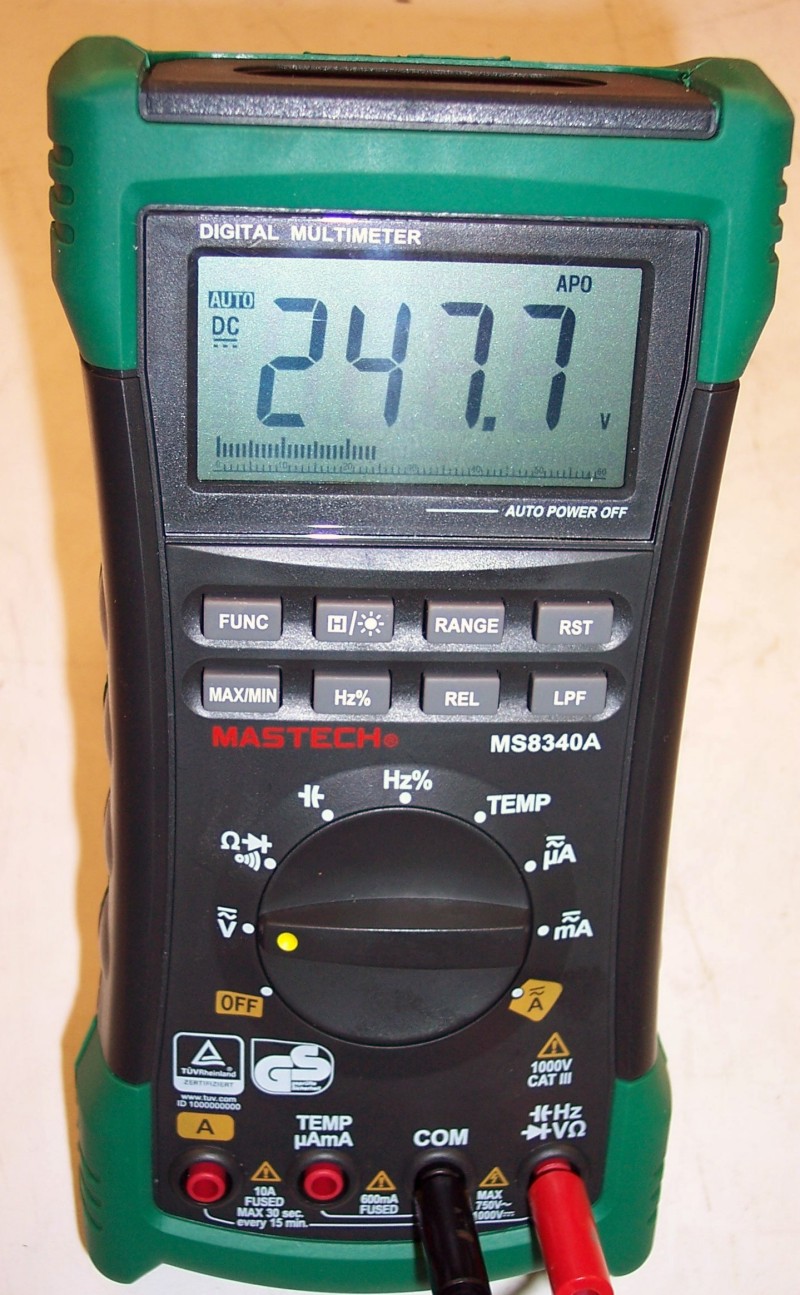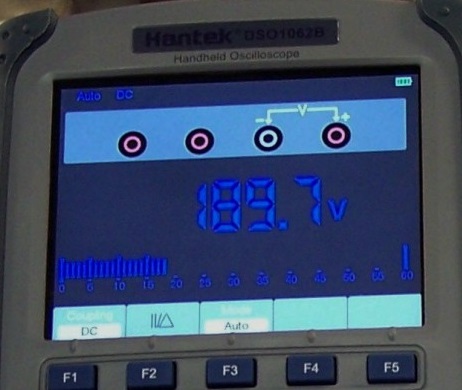
I have been messing around with bargain priced DMMs for many years. "Even a poor DMM", I rationalized, "is at least as accurate and probably more so than an analog meter". So, I finally decided to spend the money and get a really good DMM. In these times it is impossible to avoid things that are made in China. I selected a dealer that provides a state side guarantee. Something over a year ago I bought an expensive benchtop DMM but I do not use it for day to day measurements. I want to save it as a comparison standard for checking the calibration of lesser DMMs. So I bought its little brother as a compromise between accuracy and day to day knock about measurements. It seems to have the best performance for the price.

As you can see it has the usual functions plus a few that aren't readily apparent. "When all else fails, read the instruction manual". That isn't easy because the manual is written in broken English. Here is an example.
An Exact Quote From the Manual.
5 MEASUREMENT OPERATION
5.1 DC & AC voltage measurement
Warning
To avoid harms you or damage to the meter from electric shock. Please do not attempt to measure voltage higher than DC 1000V/AC 750Vrms although readings may be obtained.The DC voltage range are 600.0mV/6.000V/60.00V/600.0Vand 1000V; and then. The AC voltage ranges are 6.000V/60.00V/600.0V and 750V.To measure DC/AC voltage:
- Set the rotary switch to "line above a sine wave V" position.
- Insert the red test lead into the "VΩ" input terminal and the black test lead into the COM terminal. Default status is DC voltage measurement mode and then AC voltage measurement mode is selected by FUNC push key.
- Connect the test lead across with the object being measured.The measured value will be shown on the LCD display.
Note:
When DC or AC voltage measurement has been completed, disconnect the connection between the testing lead and the circuit under test.End of Quote From the Manual.
The whole manual is like that.
The accuracy specification is more than a bit puzzling. Here is the one for DC voltage.
Quote.
600mV/6V +/-(0.5%rdg+3dgt)60V/600V/1000V +/-(0.8%rdg+3dgt)
End Quote.
I am accustomed to seeing digital voltmeter spects of 0.1%. with an additional error of +/- 1 count. By "dgt" do they mean "count"? And why isn't that accuracy specification better.
DMMs Count.
You are probably accustomed to, the defacto standard and totally misnamed, 3-1/2 digit DMM. Someone in years past, probably from the marketing department, thought that adding a digit on the left side of a 3 digit display was equivalent to adding half a digit. Adding a complete 4th digit would increase the range by a factor of 10. A half digit increase should extend the range by a factor of 5 or some might say 3.16. A factor of 2 is a long way from being half a digit.These displays will count to 2000. But, I hear you saying, the display only goes up to 1999. Correct but you are forgetting to count the zero state. Consider the single digit case. Count on your fingers, 0, 1, 2, 3, 4, 5, 6, 7, 8, 9. Counts are important because that is how DMMs are being specified to avoid the ridiculous fractional digit claims.
This meter is advertised as a 6000 count meter. The auto ranging system upshifts when the count reaches 6001 which technically makes it a 6002 count meter. It downshifts when the count becomes 5600. That prevents the range from jumping back and forth making the display value impossible to read.
Features.
This meter measures:Additional features are;
- DC Voltage,
- AC Voltage,
- DC Current,
- AC Current,
- Resistance,
- Continuity check with audible alarm at 10 ohms and lower,
- Diode check (indicates the voltage drop at a current of 1.1 mA,
- Capacitance,
- Frequency,
- Percent duty cycle of a wave,
- and Temperature with a supplied thermocouple probe.
- Automatic power off so you won't leave it on overnight,*
- LCD readout with backlight,
- Auto ranging,
- Manual override of auto ranging on voltage, current, and resistance,
- A reset button to return to the startup conditions without turning the meter off,
- A reading hold button to hold a value in the display,
- MAX/MIN setting to find the range of a varying value,
- REL (relative setting to compare measurements,
- and a Low Pass filter for AC measurements in the presents of noise.
* Auto power off is a double edged sword because of what I feel is a design flaw. When working with the meter on the bench and making measurements every few tens of seconds it should stay on. It goes off after three minutes no matter what you do. It should have been designed so the power off timer resets anytime any function control is operated by the user or when the range changes under automatic control. I sometimes find it frustrating to be working along and suddenly the meter turns off.
DC Voltage Ranges;
AC Voltage Ranges;
- 0 to 600.0 mV,
- 0 to 6.000 V,
- 0 to 60.00 V,
- 0 to 600.0 V,
- and 0 to 1000 V.
DC Current Ranges;
- 0 to 6.000 V,
- 0 to 60.00 V,
- 0 to 600.0 V,
- and 0 to 750 V.
AC Current Ranges;
- 0 to 600.0 uA,
- 0 to 6.000 mA,
- 0 to 60.00 mA,
- 0 to 600.0 mA,
- 0 to 6.000 A,
- and 0 to 10.00 A.
Resistance Ranges.
- 0 to 600.0 uA,
- 0 to 6.000 mA,
- 0 to 60.00 mA,
- 0 to 600.0 mA,
- 0 to 6.000 A,
- and 0 to 10.00 A.
Capacitance Ranges. Note: Manual override of Auto Ranging does not function in capacitance mode.
- 0 to 600.0 Ω,
- 0 to 6.000 kΩ,
- 0 to 60.00 kΩ,
- 0 to 600.0 kΩ,
- 0 to 6.000 MΩ,
- and 0 to 60.00 MΩ.
0 to 40.00 nf, 0 to 400.0 nf, 0 to 4.000 µf, 0 to 40.00 µf, 0 to 400.0 µf, and 0 to 4000 µf. Frequency Ranges. 0.5 volts P-P sinewave input. 0.500 to 9.999 Hz, 0.50 to 99.99 Hz, 0.5 to 999.9 Hz, 0 to 9.999 kHz, 0 to 99.99 kHz, 0 to 999.9 kHz, and 0 to 9.999 MHz. There is only one range for temperature.
-10 to +700 °C,
14 to 1292 °F.Input Resistance.
The specifications page of the manual is silent on the matter of input resistance. However some testing with another meter indicates that the input resistance in the DC voltage mode is 40 megohms on the 600 mV range and 8 megohms on all others. On the AC range the DC input resistance is approximately 8 megohms. My LCR meter (to be reviewed eventually) shows 16 pf in parallel with 8.6 MΩ. There is no specification on how much DC offset on an AC signal the meter can stand without damage.AC Frequency Response and LPF (Low Pass Filter.)
The accuracy specification on AC voltage reads as follows. ±(1.5%rdg+4dgt). See above for additional comments on this notation. There is a note indicating that the frequency range is 50 Hz to 1 kHz.The reference value was set at 60 Hz.
The reading became too unstable to read below 16 Hz. The stable reading is not yet down by 1.5%.
The reading is down by 1.5% at 1.36 kHz.
With LPF switched in the upper frequency for 1.5% down is 216 Hz.AC to DC Converter.
It is not a true RMS meter. It appears to have a peak responding AC to DC converter. It is of course calibrated in terms of RMS for a sinusoidal wave.A Comparison Test.

Mastech® MS8050 DMM as standard for accuracy test.
The much discussed Fluke power supply was used as the voltage source for this test. Yes, it can be set that precisely and after a few minutes of warmup it will hold it for a good part of an hour. Connected in parallel with it are the DMM under review here, the Hantek® hand held DSO / DMM combo (soon to be reviewed here), and just for grins 3 freebees with an order of $50 (offer no longer available) I use for hard knocks measurements.

5 DMMs indicating a DC voltage of 190.00 volts.
In this picture the display on the Hantek® DSO/DMM is hard to read so I cropped off everything else and enhanced the contrast on the screen to make it easier to read.

Enhanced DSO/DMM screen showing its reading.
The MS8340A is off by only 0.05% which is much better than its specifications. Maybe the spects are pessimistic or maybe I lucked out and got a good one. Either way, I'll take it. Meanwhile the DSO/DMM is off by 0.16% and two of the knockabouts are within +/-0.1%. Even the worst of the three is only off by 0.63% which is almost an order of magnitude better than the average analog meter and still 3.3 times better than the best of the analog meters. Note: I am taking an average analog meter as having an accuracy spec of ±5% and the best as having a spec of ±2%.
Conclusion.
As you can see from the above the meter tested out to be a full order of magnitude better (10 times better) than its DC voltage specification. For the price it is very good. Except for that turn off annoyance I would give it 4-1/2 stars because of its poor accuracy specification. As it is I will give it 4.Physical.
Dimensions 8.07" x 4.02" x 2.23"
Weight 13.75 oz.
Note: Converted from metric data in manual.
Price US $46.89 from this location.